Early days in France – December 1915 to June 1916
The 130th (St John) Field Ambulance arrived in France on Saturday 4th December 1915 and spent their first 6 months or so in Theatre on the Neuve Chapel sector of the Western Front as one of the Divisions of the XI Corps – 1st Army. The units of the 38th (Welsh) Division spent the first few weeks in France being instructed in the art of trench warfare by the more experienced units of XI Corps but were soon thrown into the front line on their own.
For convenience, this part of the Unit’s history has be divided into weeks.
The SS Karnak arrived at Harve at 6am on the Saturday 4th December 1915 after what, by all accounts, was a rough and unpleasant voyage. Disembarkation was delayed because of a weak dockside crane which meant the wagons had to be unloaded before being lifted. At 12.30, the Unit left the docks and marched to No. 6 Dock Rest Camp for a night under canvas.
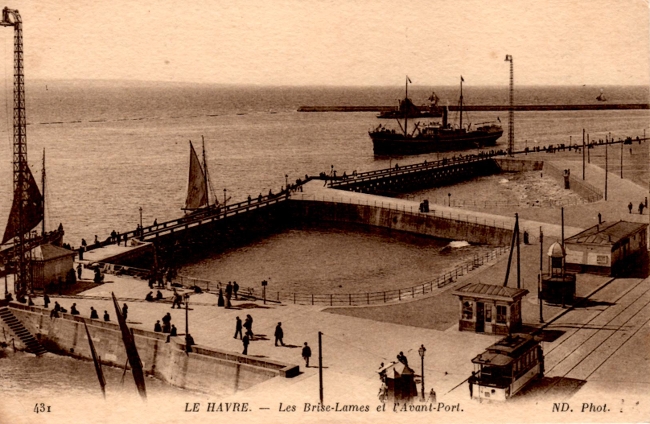
The following day, Sunday 5th December, the unit, along with a company of South Wales Borderers entrained into cattle trucks with Lt Col Davies acting as Officer Commanding (O.C.). 48554 Pte George Henry Jickells recorded in his diary that there were 24 men in each cattle truck or in the same sized trucks, 8 horses and two Army Service Corps (ASC) men. I can hardly have been a comfortable journey. The train set off at 3.20pm on an all day and night journey to Aire sur La Lys, arriving at 1pm the following day. Here the Unit, along with the rest of the 38th (Welsh) Division, were to join XI Corps (part of the 1st Army) who where holding the Neuve Chapelle sector of the Western Front. At this time XI Corps consisted of Guards Division, in line north of Neuve Chapelle and the 19th (Western) Division (new army) in line to the south with the 46th (North Midlands) Division (territorial) in reserve.
Map 1

At a stop at St Omer, Lt Col Davies was supplied with a map and position of the village where the Unit was to be billeted on arrival at Aire sur La Lys, but when they arrived, there was no one to meet them and they had no interpreter. Unloading the train was delayed due to the short platform and the unit marched off from Aire (Map 2 letter A) at 2.30pm in pouring rain and eventually arrived in pitch darkness at the village of Enguinegatte (Map 2 letter B) (population approximately 400) at 6pm, soaked to the skin having taken several wrong turns on the way. The “O.C. lost his way, (nothing unusual)” recorded 48554 Pte George Henry Jickells.
Map 2

A section of Map sheet 36A edition 6 (1916) showing the location of the Unit in Mid December 1915 – scale – each numbered square is 1000 yards square.
Although Lieut Anderson, along with a billeting party, had been sent on ahead of the Unit, great difficulty was encountered in finding billets for both men and horses as the Wiltshire Yeomanry were already stationed in Enguinegatte. Eventually, with the assistance of the O.C. of the Wiltshire Yeomanry and his interpreter, billets were finally found in barns etc. The schoolroom was used to make tea for the men but many slept without blankets, tired, wet and hungry.
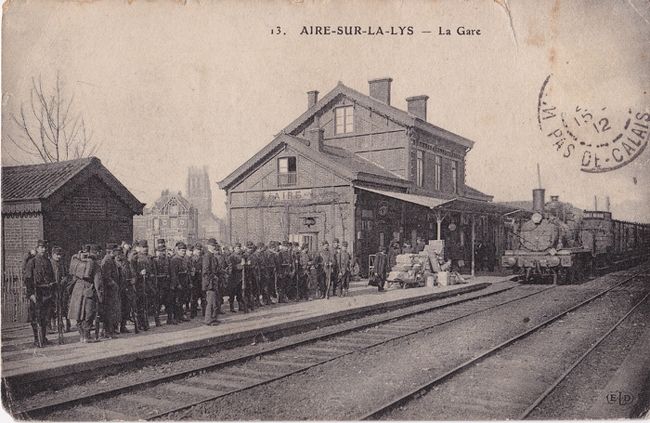
The following day was spent rearranging billets and fatigue duties and the unit was visited by the A.D.S.M. (Assistant Director of Medical Services) of the 38th (Welsh) Division – (at this time Col Morgan). Pte Ieuan Phillips 48563 reported in his diary that the men had a stew this day. Capt Ffoulkes and Capt Anderson were billeted in a house from where Capt Ffoulkes wrote to his family (papers of Annie Ffoulkes held in Bangor University Archives) from the kitchen while the adjoining room was full of men of the unit chatting and drinking cafe au lait made by Madame. He describes the local people as very good to the men, doing what they can for them but this is very little as they are so poor. He described the village as very scattered and composed mainly of small farms. “The people are happy but poor and dirty, and most of them never seem to have heard of a bath”. The Unit received orders to move at 9am the next day to Glomenghem (Map 2
letter C), a larger village, just a few miles away.
In continued wet weather, the Unit marched out of Enguinegatte at 9am and arrived in Glomengham at 1pm. The men were billeted in barns and stables while the headquarters was established in a chateau. Lieut Douglas Charles Murray Page RAMC reported himself for duty and was taken on the strength of the unit.
The wet weather continued on the 9th December when the A.S.C. (Army Service Corps) motor transport reported for duty with 4 Sunbeam Ambulances, 2 Ford Ambulances and two motor cycles. It is not clear from the Unit War Diary if the drivers for these vehicles were already on the strength of the Unit or joined on this day. Interestingly, the War Diary of the 38th Division Field Ambulance Workshop Unit (WO95/2550/2) records that 7 ambulances were delivered to the Unit on the 8th December. Perhaps the was mistaken and the seventh ambulance could well have been a Wolseley as pictured below.
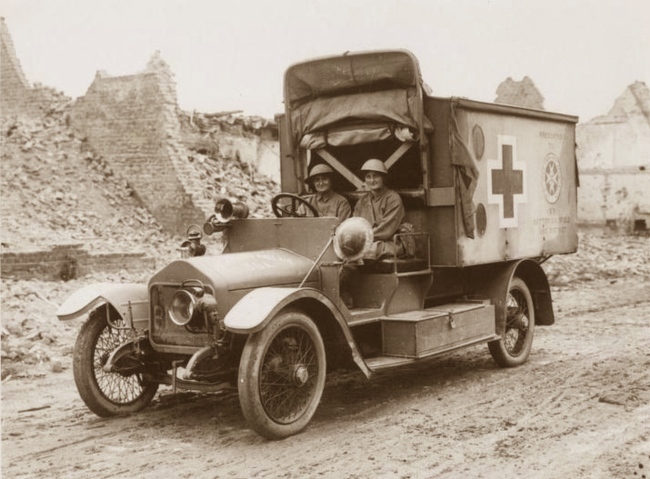
The Unit was ordered to collect the sick of the 113th and 114th Brigades and transport them to the hospital established by the 129th Field Ambulance at Clarques about 6 Km due west of the Unit’s current location.
Also on the 9th December, 48615 Pte John H Roberts was examined and passed as a motorcyclist by the 38th Div Field Ambulance Workshop Unit.
On the 10th December, the Unit continued to collect the sick from the 113th and 114th Brigades and a route march was held. Capt Anderson had a difficult and frustrating task in obtaining the cash to pay the unit, attending the Brigade Headquarters at 10 am, then proceeding to Divisional Headquarters at Roquetoire and finally being sent to Merville, some 25 Km away and finally managing to obtain the cash for the Unit by 6pm!
2nd Week at War – 11th – 17th December 1915
Saturday 11th December was again wet and miserable but the men did at least receive their 1st pay while on active service in France. 48563 Pte Ieuan Phillips received 10 Francs but was unhappy as he had no cigarettes!
On the 12th December, the Unit received instructions to open a hospital and a suitable site was found a few kilometres to the east, in the village of Rincq (Map 2 letter D). A Section with Capt A J Andrews in command, were detailed to clean and establish the hospital and by 6 pm it was ready to receive patients. On the following day, the tent sub-division of A Section were sent to the hospital for duty with the remainder of the Unit going on a route march or doing fatigues.
Tuesday the 14th December saw the men of the Unit continuing with fatigue duties, including laying roads for the motor ambulances at both the Headquarters (Glomengham) and at the Hospital (Rincq) and this work continued on through the following day. Lieut Elliott was sent on the 16th December to take on the duties of Lieut Pennant (MO 13th Welsh), who had been sent to hospital. Instructions were received for A Section to proceed to the 9th Field Ambulance for instructional purposes. This was common practice and companies/sections of all the Units of the 38th (Welsh) division were attached in rotation to equivalent Units of the more experienced and battle hardened divisions of the XI Corps to gain experience. B Section took over the Hospital, taking over from A Section who departed for Estaires by motor bus at 1.30pm under the command of the O.C. Lt Col Davies. Captain Andrew and Lieut Buckley were the other two officers of A Section. The acting O.C. the 9th Field Ambulance was Captain Fraser and the Unit had it’s headquarters is Estaires, an Advanced Dressing Station (ADS) at Laventie and an Aid Post at Red House. Groups of 12 men under the command of an Officer were attached to the ADS in rotation while the remainder of A Section were attached to their corresponding departments of the 9th Field Ambulance.
The official War Diary of the Unit state there was ‘nothing to report’ on Friday 17th December but 48563 Pte Ieuan Phillips who, as part of B Section, was manning the Hospital at Rincq appeared pleased to report that he had roast meat for dinner.
3rd Week at War – 18th – 24th December 1915 – Calonne
The stretcher bearers of the Unit underwent a Gas test on the 18th and that evening, orders were received from the A.D.M.S. to send forward on the following day a party consisting of 1 Medical Officer and 12 men to take over the Field Hospital at Calonne, which was the centre of the 38th (Welsh) Division rest area at the time. On the 19th December, Lieut Elliott returned from duty with the 13th Welsh. Capt Ffoulkes led the advanced party which included 48563 Pte Ieuan Phillips, which left Rincq by car and arrived at Calonne via Merville at 6.30pm to prepare to take over the Hospital.
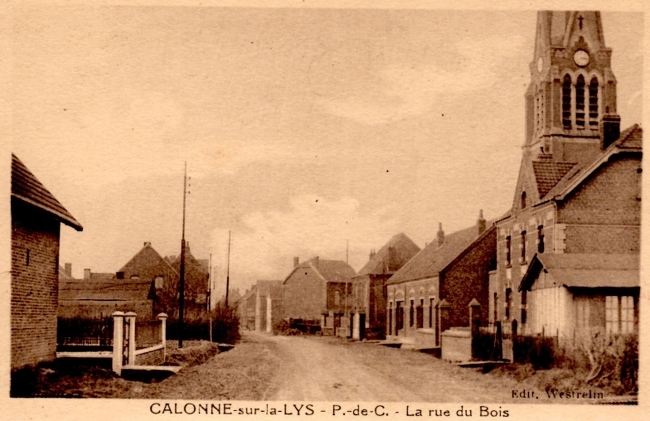
The Unit marched out of Glomenghem at 7.30am on the 20th December and arrived at Calonne by 2.30pm, their journey being delayed by the 113rd Brigade who had taken the wrong road and so blocked the path of the 130th (St John) Field Ambulance. The wagons had to be left on the road as no wagon park had been arranged for them at Calonne. The Unit received 31 patients into the hospital on the day they took it over. The Hospital was established in the village schoolroom and Capt Ffoulkes and Capt Anderson had rooms in the schoolmaster’s house. The whole village was described by Capt Ffoulkes as being very dirty and the roads to be in a hopeless state. Troops and transport pass through the village continuously almost all day. Calonne was very much closer to the front line and the sound of shell fire could clearly be heard at the hospital. Over the next few days the hospital was gradually put in order, billets were found for the men and standing and a park was obtained for the horses and transport of the Unit. On Christmas Eve, A Section returned to Calonne and so the whole Unit was together for their first Christmas at war.
4th Week at War – 25th – 31st December 1915 – Calonne
The men of the Unit were permitted to observe only Christmas day and Boxing day as days of rest and recreation in so far as emergencies would allow. 48563 Pte Ieuan Phillips records that Christmas day was “very enjoyable” and that they had a lovely meal and pudding. On Boxing Day, B Section handed over the running of the Hospital to C Section and departed at 9.30am for Vieille Chapelle to be attached to the 57th Field Ambulance for a weeks instruction. B Section consisted of 60 men under the command of Capt Ffoulkes along with Lieut J Burke and Lieut D C M Page. The three officers took it in turn to take a party of a dozen men or so up to the A.D.S. of the 57th Field Ambulance at St Vaast for 2 days. St Vaast is located about 3 km east south east of Vieille Chapelle and was about 2 km from the front line and is now the site of the St Vaast Post Military Cemetery. Capt Ffoulkes with his party relieved Lieut Burke on the 29th December. According to Capt Ffoulkes’ letters, the A.D.S. was located in an orchard about 300 meters from the communication trench and consisted of a semicircle of splendid dugouts one of which was especially large for the treatment of the wounded. On the morning of his arrival at the A.D.S., Capt Ffoulkes took six of the men into the trenches and records that they had quite an exciting time. They had to keep their heads low as they walked along the 1km zig-zag communication trench as if they stood erect, their heads and shoulders would show above the parapet and there was a German machine gun trained on the trench. Having reached the reserve trench, Capt Ffoulkes left the men with the Regimental Medical Officer of the 9th Welsh and went on to the front line trench. He recalls that “it was strange to feel that you were within 100 yards of the Germans – it’s the nearest I’ve been to them yet and I didn’t want to get any nearer”. He further records that British Field Artillery Batteries were posted all around the A.D.S. and kicked up an infernal din at times, especially a battery of 18 pounders situated about 80 meters behind the A.D.S. In the evening, they enjoyed sitting on the roof of their dugout, watching the British shells bursting over the German trenches until the German guns began to return fire when they felt it best to retreat into the safety of the dugout.
At the 9am parade on the 27th December, Lt Col Davies read out to the Unit at Calonne the Christmas Message to the Troops from His Majesty the King. Arrangements were made with the representative of the Mayor of Calonne, for the Unit to take over the remaining classroom of the school on the night of the 29th for a week.
5th
Week at War – 1st – 7th January 1916 – Calonne
The Unit began the new year still based at Calonne. B Section returned to Calonne from their training with the 57th Field Ambulance on the 2nd January and C Section consisting of 3 Officers and 60 men departed on foot the following day under the command of Capt A W Anderson to be attached to the 59th Field Ambulance at Locon.
On the 5th January, two horse drawn ambulances were detailed to follow the route march of the 10th and 15th Battalions, the Welsh Regiment to pick up stragglers.
B Section, composed of 2 Officers and 61 other ranks under the command of Capt M Ffoulkes, proceeded by route march on the 6th January to take over an Advanced Dressing Station (A.D.S.) at Green Barn. On arrival, all transport with the exception of 2 motor ambulances, one water cart and one limbered wagon were sent back to Calonne. This was the first time the men of the Unit were in action on their own and by all accounts, acquitted themselves well as can be seen below on the 8th January.
With the departure of B Section, C Section still away with the 59th Field Ambulance and several of the remaining Medical Officers acting temporarily as Medical Officers (MOs) for Infantry Battalions of the Brigade, this left just Capt Andrew as the only Medical Officer at the Unit headquarters at Calonne but fortunately, Lt Burke returned from duty with the 14th Welsh later that day and Lt Anderson returned from C Section the following day.
6th
Week at War – 8th – 14th January 1916 – Calonne
Both 48563 Pte Ieuan Phillips and 48119 Pte George Groves in their diaries and 48196 Geo Thomas in a letter to the Amman Valley Chronicle, record that on the 8th January, at Green Barn, B Section brought in wounded Royal Field Artillery (RFA) men under heavy shellfire and were complimented by the Major of the RFA battery for their coolness and pluck! Capt Ffoulkes records in a letter dated 17th January that “The men worked splendidly, particularly the stretcher bearers. It requires a good deal of nerve to carry wounded steadily and carefully over rough ground under shell fire but the men never hesitated once and I know they will always behave in the same splendid manner.”
Late in the evening of the 8th January a telegram was received by the Unit instructing that the four Army Chaplains who had been attached to the Unit were to return to the 114th Brigade Headquarters at Laventie but before they departed the following morning, Capt J Allan Davies C.F. reported sick with colic and was evacuated to the Hospital for Officers at Robecq. The three other chaplains departed at 11.30 in accordance with instructions.
C Section returned to Calonne from their time with 59th Field Ambulance on the 10th January and on Friday 14th B Section, under the command of Capt M Ffoulkes returned having handed over the A.D.S. at Green Barn to a Section of the 131st Field Ambulance.
Also on Friday 14th January, two A.S.C. men were transferred to the Unit from the 38th Division Field Ambulance Workshop Unit, M2/047525 Pte E P Foley and M2/053713 Cecil Maurice Gardiner.
7th Week at War – 15th – 21st January 1916 – Calonne
The ADMS, 38th (Welsh) Division visited the hospital at Calonne on the 16th and the ADMS XI Corps visited the following day and expressed satisfaction with the hospital the Unit had established. On the 16th, 48563 Pte Ieuan Phillips recorded that he received his 4th pay in France, 10 Francs and on the next day the men were issued new boots – ‘and about time too, my socks were touching the ground’ he reported.
On 18th the OC of the 59th Field Ambulance visited to discuss the exchange of hospital locations by the two Units and 48563 Pte Ieuan Phillips was sent to the Officers’ mess to relieve 48560 Pte Tom Oldham for the day where he ‘had some good food incidentally’.
The 21st saw 2 men being severely punished for the wrong use of Green Envelopes (also know as honour envelopes – not to be opened or delayed by the censor) records 48563 Pte Ieuan Phillips.
8th
Week at War – 22nd – 28th January 1916 – Calonne
Many of the men spent the 22nd packing up and preparing to move on the following day and on Sunday 23rd January, under instructions of the ADMS, Capt M Ffoulkes and a section of men (probably B Section) proceeded to Rue De Bois to take over the ADS there from the 59th Field Ambulance. Capt Ffoulkes wrote home that the Unit was pleased to leave Calonne “We are glad to move out of this place as it is hopelessly dirty – almost as dirty as the rest camp in Havre where we spent the first night after landing on French soil. The weather has been fair on the whole lately but there always seems to be tons of mud about here and it gets scattered all over the place by heavy motor traffic.” On the 24th, the remainder of the Unit proceeded by Route March to Mesplaux (also know as Mesplaux Farm) – to take over the Field Hospital there from the 59th Field Ambulance, arriving at 1.30pm. Mesplaux Farm is situated about 1.5 km south east of the village of Locon and Rue de Bois (now a British Military Cemetery) is about 1 km further to the south East. In a letter home dated 29th January, Capt Ffoulkes described Mesplaux Farm as “a rambling old place built in 1715 – an old convent which I have not seen but which I am told is very interesting and dirty!”
The 59th Field Ambulance had occupied Mesplaux Farm on and off since late September 1915 and their war diary (National Archives WO95/2073/1) contains the following description of the place – The farm consists of a square of buildings surrounded by a moat approximately 15ft wide and 6ft deep including the mud. On the south side the house was situated, on the west a large barn or storeroom, on the east the entrance under an archway with cow houses on either side. In the midst three middens and a cesspool intersected by paved roadways.
The plan below of Mesplaux farm is also from the war diary of 59th Field Ambulance.
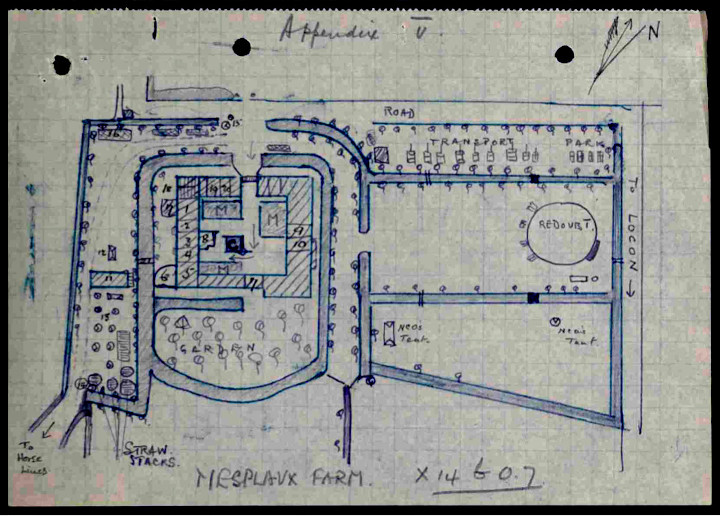
Key to numbers in the above plan
- End section of large barn filled up with straw.
- Dressing room for lying cases.
- Ward for lying cases.
- Dressing room for sitting cases.
- Lying down space for sitting cases.
- Buffet.
- Packstore.
- Office.
- Officers ward.
- Medical store and small room attached to officers ward.
- Barn fenced in with straw walls for lying cases.
- Operating tent.
- Operating tent and 8 bell tents for sitting cases.
- Mortuary.
- Guard tent.
- Pit covered with tarpaulin for personnel.
- Cook house for hospital.
- Latrine, urinal and incinerator for hospital.
- Room for sick (previously guard room).
- Room for personnel (19+20 old cow sheds)
- Bridge.
The men at Mesplaux farm spent the 25th doing fatigues and cleaning up the place, as did the men at Rue de Bois. The first casualty arrived at the hospital at 7.45pm – a soldier from the 13th Royal Welsh Fusiliers. Unlike their stay at Green Barn earlier in the month, Capt Ffoulkes and the men with him had a much quieter time of it and according to 48563 Pte Ieuan Phillips, apart for fatigues, football was played frequently. Capt Ffoulkes recorded in a letter home that the A.D.S. at Rue de Bois consisted of a farmhouse, the men sleeping in 3 fairly comfortable barns and a 4th barn being used as a dressing room. While at the A.D.S., Capt Ffoulkes and Lieut Anderson had their mess on the first floor of a second rate estaminet but at least they were able to buy eggs and wine! On the 28th, Capt Ffoulkes wrote in a letter home that the Hun shelled the area around the A.D.S. very heavily and while the A.D.S. was not hit, one man and a horse were killed in the neighbourhood. On the follow day he recorded that the dead horse was still lying in a field near the A.D.S. with his legs up in the air. “Nothing looks quite so dead as a dead horse.” he commented.
In the early hours of the 29th, Capt Ffoulkes was called to assist a pregnant women in labour who lived in a poor, shell damaged cottage in a road known as “Grub Street” some 3/4 mile away from the A.D.S. It was tricky for him to get there but he could not dream of refusing to go. He goes on to comment that the delivery was quite normal but it would have been awkward if forceps had been required. The first and possibly the only child, a girl, delivered by the 130th (St John) Field Ambulance! He returned and visited mother and child on the same evening and recorded that mother and daughter were doing well!
Major General Ivor Phillips DSO, the Commanding Officer of the 38th (Welsh)
Division visited the hospital on the 28th January and was clearly impressed by
what he saw as we will see later.
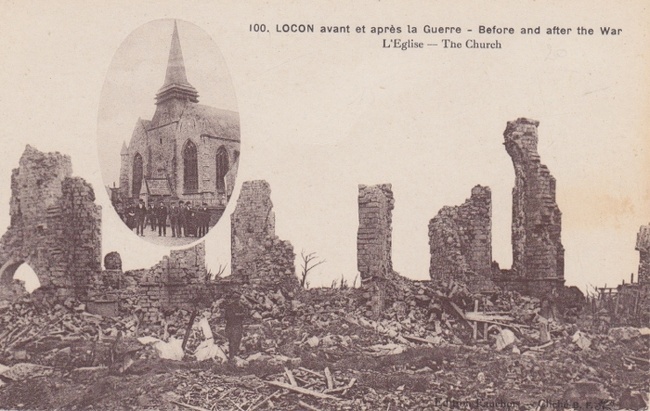
Locon Church before and after the war from an original photo-poastcard. Locon was only 1.5km north west of Mesplaux Farm and so must have been well known by the men of the Unit.
9th
Week at War – 29th January – 4th February – Mesplaux Farm
The D.D.M.S. 11th Corps accompanied by the A.D.M.S. 38th (Welsh) Division visited the hospital at Mesplaux Farm on the 29th February. For the remainder of the week, the men not employed on medical duties were on fatigue work, carrying out improvements on and around the hospital, making paths, levelling off the ground and whitewashing walls etc. At the A.D.S., things remained quiet, with football being played daily according to 48563 Pte Ieuan Phillips until at 8.30pm on the 4th, the football field was shelled.
10th
Week at War – 5th – 11th February – Mesplaux Farm
The ADMS and DADMS of the 38th (Welsh) Division, along with the OC, Lt Col Davies, visited and inspected the ADS and the Aid Post at Tube Station. On Tuesday 8th Feburary, the ADMS gave instructions when he visited the Unit, that 4 men were to be posted at Tube Station Aid Post and 2 at the junction of Cadbury Corner and Princes Road but when it was discovered that there was no accommodation at Cadbury Corner, the two men were posted at Path House Post. On Wednesday, Capt Anderson, Capt Ffoulkes, Lieut Anderson and Lieut Elliott attended a Gas lecture at the recreation room at Lestrem.
11th
Week at War – 12th – 18th February – Mesplaux Farm
Apart from the usual visits by the A.D.M.S., the early part of the week was quiet according to the War Diary but on Tuesday 15th, the hospital and A.D.S. were visited by Mr Owen Owen, Secretary of the Welsh Army Corps. In accordance with instructions from the A.D.M.S., the A.D.S. at Rue de Bois and the Aid Posts at Tube Station and Path House Post were handed over to a party from the 131st Field Ambulance on the 17th. On the 18th, Lt/Col Davies in company with Major Hayton D.A.D.M.S. of the 61st Division and also Major Mackie of the same Division visited the A.D.S. of the 5th Field Ambulance at Marais and also the Aid Post at Festubert.
12th
Week at War – 19th – 25th February – Mesplaux Farm
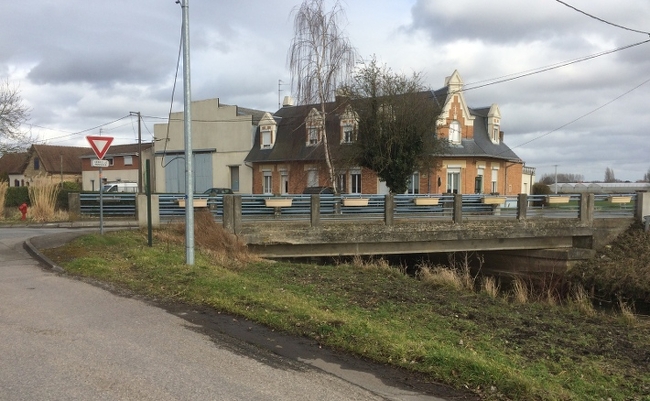
On Saturday 19th, Capt Ffoulkes with 12 other ranks left at 08.30 am to take over the A.D.S. at Marais and on the following day, a further party of men left for the A.D.S. at Marais. Later in the day, Lt/Col Davies visited both the A.D.S. at Marais and the Aid Post at Festubert (Map 3. C) situated in an estaminet, which was being heavily shelled at the time. Also on Sunday 20th, Lt Col Walton, Officer Commanding the 107th Field Ambulance, arrived with 3 officer and 55 other ranks who were attached to the Unit for instructional purposes. In just a few short months, the 130th (St John) Field Ambulance had gone from trainee to trainer!
On Monday the 21st, General Pike DMS inspected the Unit, the Hospital at Mesplaux Farm, and the Advanced Dressing Stations and congratulated Lt Col Davies stating that; “He had known this farm for a good many months and it had always appeared to him to be a hopeless place to convert into a Field Hospital but he could now state it was now one of the best, if not the best kept Field Ambulance in the 1st Army.” High praise indeed and a testament to Lt Col Davies being a stickler for things being done properly and to the hard work of the men of the Unit.
The following morning there was a heavy fall of snow and the weather continued to be very cold with intermittent snow falls into Wednesday when the Unit received further praise from both Col T J Morgan A.D.M.S. 38th (Welsh) Division as well as from Major General Ivor Phillips, the Commander of the 38th (Welsh) Division who wrote. “Will you please convey to all the Officers, NCOs and men of the three Field Ambulances and of the Sanitary Section and Bacteriological Laboratory my congratulations. I have watched their work since they have been in France with much interest and have noted their steady progress. I hope this satisfactory report will be an incentive to all ranks for further effort so that the Field Ambulances of the 38th Division may eventually be held as second to none in the Army.”
On Friday 25th, the Unit was visited by a number of Staff Officers accompanying a group of American journalists.
13th Week at War – 26th February – 3rd March – Mesplaux Farm
Quite a number of patients were admitted on the night of 26th records 48563 Pte Iuean Phillips, who was on night duty at the time. Lt Col Walton and C Section of the 107th Field Ambulance returned to their Unit on the 27th February and were replaced by A Section of the 105th Field Ambulance. On the 29th, Capt Anderson and Capt Ffoulkes departed for two weeks leave and Lieut Page proceeded to the 14th Welsh Regiment to act as RMO in place of Lieut McMillan who had been taken ill.
The Unit continued to improve the facilities in and around Mesplaux Farm with a large number of men employed in making a new horse standing on the 1st March.
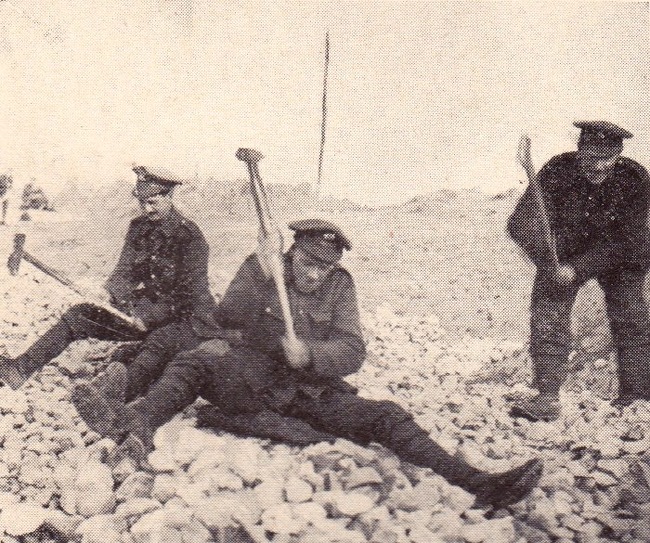
Road building and a new horse standing – it was never just medical work for the men of this Unit. This area of the Western Front was relatively quiet at this time and little of note happened during the rest of the week although the weather did improve and in spring sunshine, numerous aeroplane duels were visible overhead.
14th Week at War – 4th – 10th March – Mesplaux Farm
On Saturday the 4th March it snowed again. More space was obtained at Mesplaux Farm with permission being granted for the Unit to use a Granary as accommodation for 40 men. The weather remained cold and there was a further heavy fall of snow in the evening. A section of the 105th Field Ambulance departed from the Unit at 10am on the 5th having completed their week’s instruction. Further improvements were made to the Hospital and headquarters at Mesplaux Farm with a joiner’s shop being erected on the 7th and work on the horse standing was proceeded with on the 9th. Lt Col Davies visited and inspected the advanced dressing station every few days.
Friday 10th was the 8th payday for the Unit and 48563 Pte Ieuan Phillips received 10 francs.
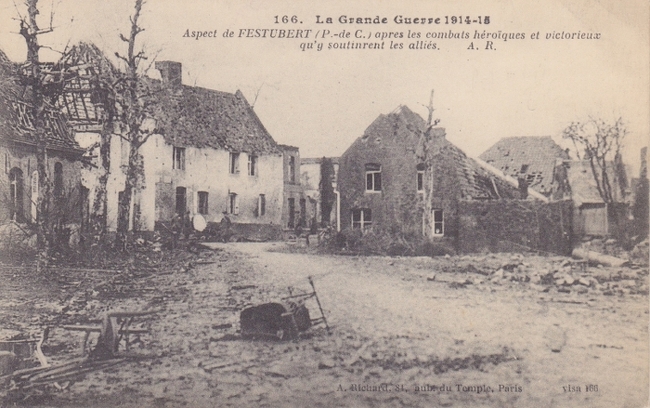
15th Week at War – 11th – 17th March – Mesplaux Farm
A concert was held in the Barn on the evening of Saturday 11th with a Piano being acquired for the occasion. This was a huge success and very enjoyable records 48563 Pte Iuean Phillips. During this week, the weather remained very changeable, varying from warm, fine days to very cold and snowing. On Monday 13th, instructions were received by the Unit to make arrangements at the Bearer Post at Festubert to dry the socks of the 2 Battalions in the trenches and to massage the feet of the men who required such treatment, with whale oil.
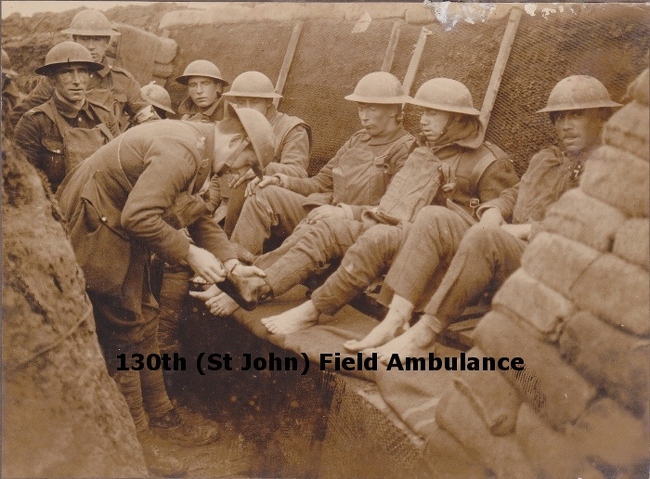
Strict attention to foot hygiene was essential in the wet conditions that the soldiers were forced to live and fight in and regular inspections were a necessary duty to help prevent ‘trench foot’, a serious and debilitating condition caused by standing in cold wet mud/water for long periods, but it can not have been the most pleasant task for the men of the Unit. On the following day, the Horse transport of the Unit was inspected by the Officer Commanding the 38th (Welsh) Divisional Train (Transport rather than steam engine) and stated that it was the best kept transport he had yet seen in the Division. More praise for the Unit’s hard work.
The D.D.M.S. II Corps and the D.A.D.M.S. 38th (Welsh) Division visited the Hospital at Mesplaux Farm on Thursday and on the following day Lieut Elliott proceeded to the 13th Royal Welsh Fusiliers (RFW) to act as temporary Medical Officer (MO) and Lieut Burke proceeded to 232nd Company Royal Engineers (RE) for the same purpose.
16th Week at War – 18th – 24th March – Mesplaux Farm
The weather remained very cold all this week with further snow falls on Friday 24th which was also the Unit’s 9th payday in France.
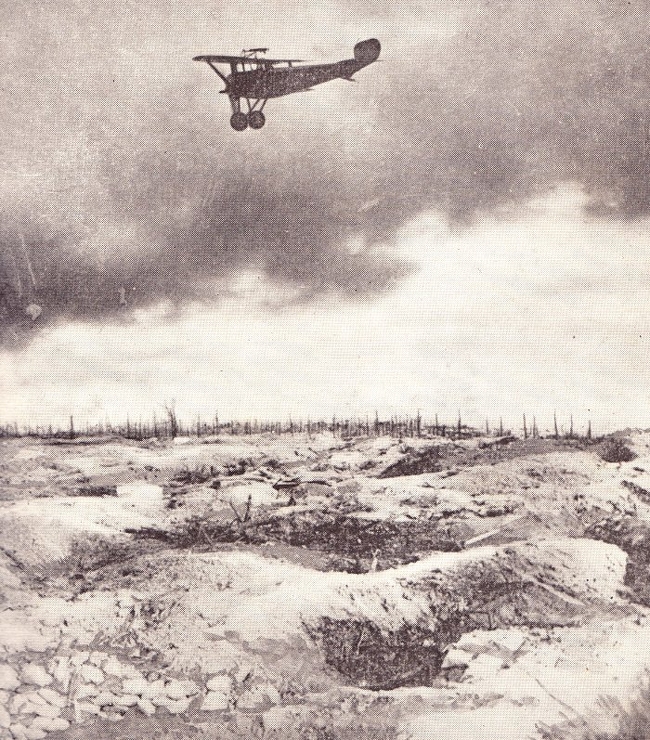
Things remained fairly quiet for the Unit with little reported in the War Diary for the week except for the regular visits to the Unit by the A.D.M.S. and D.A.D.M.S. and the O.C. visiting the Advanced Dressing Station (A.D.S.). On the 20th, Lieut Buckley proceeded to the 10th South Wales Borderers (S.W.B.) to act as temporary M.O.. This temporary attachment of the M.O.s of the Unit to other units in the Division was common. The infantry Battalions and other units only had a single M.O. and if they went on leave, were sick, wounded or killed, this left them with no medical cover, so the Field Ambulances of the Division with 9 or more M.O.s would fill in for these M.O.s until they returned to duty or were replaced.
17th Week at War – 25th – 31st March – Mesplaux Farm
Major W Bickerton Edwards reported for duty on Sunday 26th March, his arrival from England having been delayed by ill health. His arrival was not welcomed by all, Capt Ffoulkes at the A.D.S. wrote in a letter to his family’ “Major Edwards has returned to us too. He looks very well and has completely recovered but I don’t think any of us are frightfully keen on having him back. He and Col Davies came to see me yesterday (27th/28th March) . I believe there is some discontent amongst the Officers at Headquarters already. Major Edwards is so bigheaded and it is a shame that he should come and upset everything when we have always been happy together without friction. It is a pity he was not kept at a home station.”
On the following day, 96 men of the Unit were inoculated against typhoid and many of them may well have had an agonising night and been sore and unwell for several days as 48563 Pte Iuean Phillips did. Certainly, Capt Ffoulkes records that he felt “rather seedy” for a few days afterwards.
Having been with the Unit in France for less than a week, Major W Bickerton Edwards was attached to the 129th Field Ambulance and he was struck of the strength off the 130th (St John) Field Ambulance on the following day which 48563 Pte Phillips records as “Rough luck”.
18th Week at War – 1st – 7th April – Mesplaux Farm
The weather improved considerably this week becoming much warmer and dryer and there was plenty of aeroplane activity in the skies above the Unit

Captain A J Andrew departed from the Unit on the 1st April and was struck off the strength and on Monday 3rd, Lt Col Davies departed for leave (“I wish I was going too.” records 48563 Pte Phillips) and Capt A W Anderson took over charge of the Unit in his absence. On the same day, Lieut Elliott returned to the Unit from the R.W.F. where he had been acting as R.M.O.
On Tuesday 4th, A Section of the 132nd Field Ambulance arrived for instruction and training while Lieut Buckley proceeded to the 10th S.W.B. to act as temporary M.O. while their M.O., Lieut Evans was attached to the 130th (St John) Field Ambulance for light duties.
By the 5th April the 38th (Welsh) Division was holding the front line between Festubert in the north and Givenchy in the south. The Divisional headquarters was based in Locon, the 114th Infantry Brigade was holding the left (north) sector, the 115th Infantry Brigade the right (south) sector and the 113rd Infantry Brigade was in reserve.
Post-graduate medical education continued even while the Unit was on active service and a clinical afternoon was held at the Unit on Thursday 6th April and a number of medical officers from the other units of the Division including the A.D.M.S. were present. Papers were presented by Capt Day on the work carried out at Aid Posts and another by Lieut Anderson on the treatment of wounds as carried out at the Unit’s hospital. The War Diary states that these papers were followed by a most interesting discussion in which the views of different medical officers were expressed. Nothing much has changed in a 100 years!
The next day the D.D.V.S. (Deputy Director Veterinary Services) 1st Army inspected the horses of the Unit and expressed satisfaction on the condition they were in.
Friday the 7th April was the Unit’s 11th payday in France.
19th Week at War – 8th – 14th April – Mesplaux Farm
This week began dry and fine but turned increasingly wet from Tuesday for the rest of the week. Lieut F A Anderson and Lieut Burke attended a lecture by the Clinical Adviser to the 1st Army at Aire sur La Lys. On Sunday, two church parades were held at the Unit, one at 9.15am for the Church of England and one at 11.15 am for the Nonconformists.
The 38th (Welsh) Division was ordered to relieve the 35th Division in the Fauquissart sector and the 19th Division in the Moated Grange sector between the 14th and 18th of April. By this time, the 113rd Infantry Brigade had replaced the 115th Infantry Brigade in the line.
Captain A W Anderson, on instructions from the A.D.M.S. 38th (Welsh) Division, visited the hospital of the 59th Field Ambulance at La Gorgue and the A.D.S. at La Flinque which the 130th (St John) Field Ambulance was shortly to take over.
On the following day the A.D.M.S. 39th Division and the A.D.M.S of the 38th (Welsh) Division visited and inspected the Unit’s Hospital at Mesplaux Farm and Capt A M Payne delivered a lecture in the afternoon based on the lectures given by the Chemical Adviser.
Lieut Page returned to the Unit from the 13th Welsh Regiment (W.R.) where he had been acting as M.O. in place of Lieut Watkins.
20th Week at War – 15th – 21st April – Mesplaux Farm – La Gorgue
Lt Col Davies returned from leave on the 15th April and, the next day, a party under the command of Lt Buckley consisting of 2 Officers and 36 other ranks of C Section proceeded to Laventie (Map sheet 36 G34. c7.3) at 8am to take over the A.D.S. there from the 105th Field Ambulance (35th Division), arriving at 12.30pm. At the same time, an advanced party of the 134th Field Ambulance (39th Division) took over the A.D.S. at Marais from a detachment of the Unit who returned to the Headquarters at Mesplaux Farm. On Monday 17th, a further party of the Unit, under the command of Capt Ffoulkes with Lieut Burke and 36 other ranks proceeded to La Flinque Map sheet 36 M10.c7.1 to take over the A.D.S. there from the 59th Field Ambulance. The Headquarters and Hospital at Mesplaux Farm were handed over to the 134th Field Ambulance on the 18th and the Unit proceeded by route march to La Gorgue and took over the Dressing Station Map sheet 36A L34.b6.2 there from the 59th Field Ambulance. 48135 Sgt C. W. Jarman and 48563 Pte Phillips stayed behind to hand over the Army Stationary equipment and the 15 patients remaining in the Hospital and left Mesplaux at 11am and arrived at the Unit’s new location in La Gorgue at 12.30 to find the Unit had already arrived and were unpacking for all they were worth.
Map 6
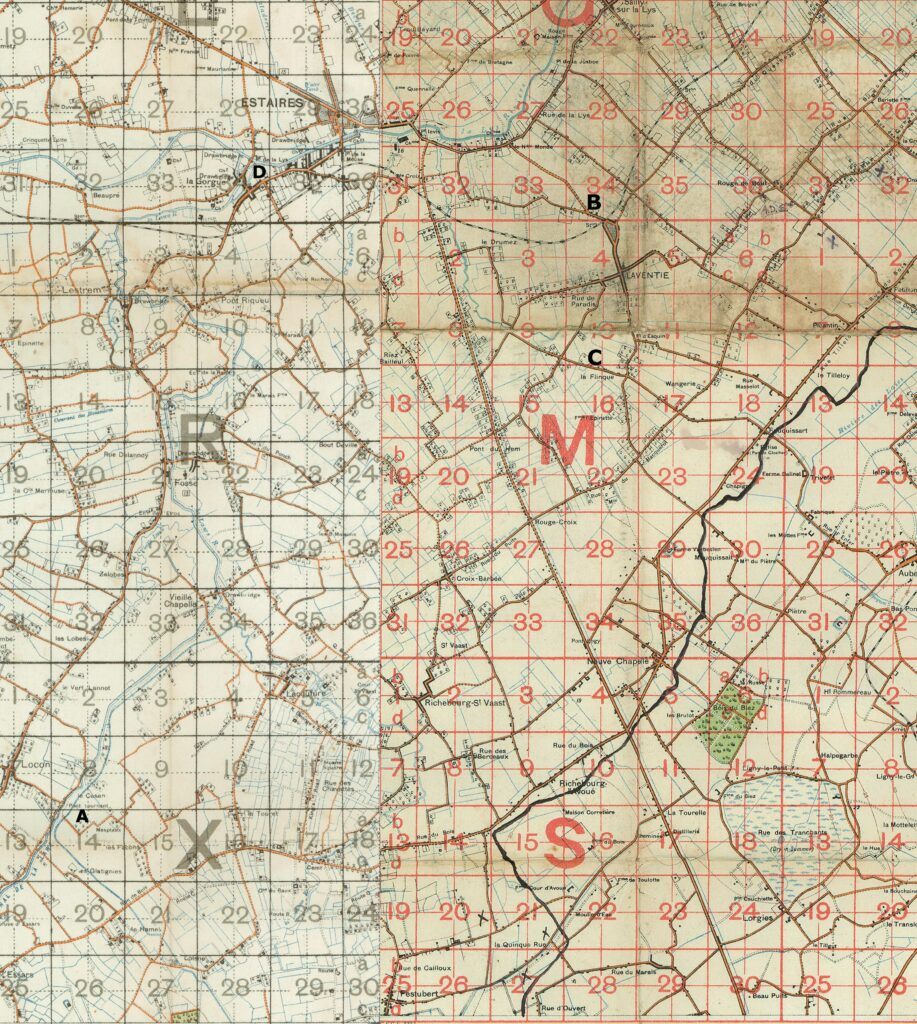
A Mesplaux Farm M.D.S., B Laventie A.D.S., C La Flinque A.D.S., D = La Gorgue M.D.S. The front line trenches are marked by the black line running diagonally across the lower right corner of the map.
The Hospital at La Gorgue was located on the main road in the centre of La Gorgue and 48072 Sgt John Reeves Davies described it as a fair sized village and much better than there previous location. 48563 Pte Phillips records that the first few days at La Gorgue were very busy with quite a number of casualties being admitted and as well as the weather being wet and miserable, he suffered from a splitting headache and earache for several days.
Capt Ffoulkes described the A.D.S. at La Flinque as “situated in a very lonesome spot. There are no civilians about at all – our only companions are rats which infest wrecked houses about us.” and the A.D.S. itself as “the usual old farmhouse on the roadside, but it is bad repair. The Germans have shelled the whole place fairly severely and there is a good deal to be done to make it moderately comfortable for the reception of wounded and for ourselves”.
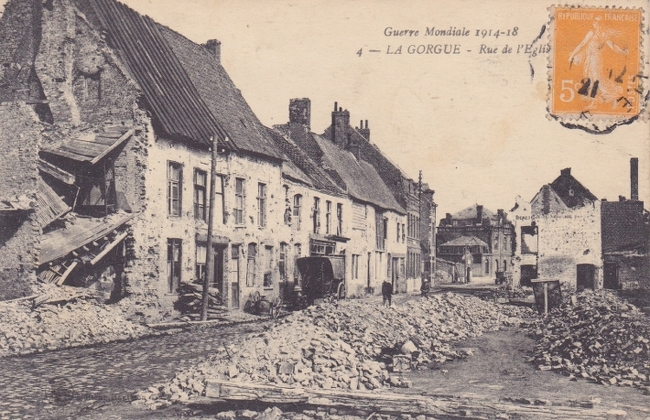
As was Lt Col Davies’s way, the following day men not on hospital duties were put to work cleaning up the Hospital and adjacent buildings. The O.C. as well as the A.D.M.S. and D.A.D.M.S. visited the A.D.S. at Laventie. Lt T B Evans who had been attached to the Unit for light duties on the 4th April was transferred to the 131st Field Ambulance this day.
On Good Friday, 21st April was the Units 12th payday in France and special church parades were held for the Church of England at 9.30am and for the nonconformists at 11.30am. A Divisional concert was also held. The O.C. visited and inspected the A.D.S. at Laventie and the Aid Post at Red House and Hougamont. 48554 Pte G H Jickells recorded in his diary that he spent Good Friday as one of the four stretcher bearers from the Unit, at Hougamont Aid Post and Easter Monday at Red House Aid Post.
21st Week at War – 22nd – 28th April – La Gorgue
(Map sheet 36A L34.b6.2
The weather during this week was recorded as ‘perfect’ by Capt Ffoulkes in a letter home, but he went on to say that “in fact it has been uncomfortably hot some days about midday but the warmth is so welcome. The only misfortune is that most of us still have our winter clothes which are not very comfortable nowadays”. He requested that some lighter underclothing and light breeches be sent to him.
While the 38th (Welsh) Division was in this sector of the line, the Divisional headquarters were located at La Gorgue, the129th Field Ambulance was based at La Gorgue (Map sheet 36A L35.b9.9) with their A.D.S. at Green Barn (Map sheet 36 M27.d5.2) and the 131st Field Ambulance was based at Regnier Le Clerc (Map sheet 36A K34.d8.8). The 129th Field Ambulance was responsible for the evacuation of casualties on the right of the Divisional sector and the 130th for the left and the 131st for the area west of La Gorgue.
The various field ambulance units of the Division were allocated specialist tasks by Col Morgan A.D.M.S. 38th (Welsh) Division. During this phase in the line, the 131st Field Hospital covered the rear area of the Divisional sector and one section was posted to man the Corps Rest Station (C.R.S.) at Merville (Map sheet 36A K29.d1.9) and deal with men with skin diseases and scabies. Men in the forward area with such conditions were to be sent to the 129th Field Ambulance for transfer onward to the 131st Fld Amb. The 130th (St John) Field Ambulance was to be the location for dental treatment. Initially men with dental conditions in the forward area were to be sent to the 130th (St John) Field Ambulance at 6pm on Mondays and Fridays but this was changed on the 23rd April in an order from the A.D.M.S. to 9am on Fridays when a Dentist will attend the Unit to provide specialist dental care. Col Morgan pointed out in this order dated 23rd April 1916 (The National Archives WO 95/2543/1) that “It must be understood that although Dental Surgeons visit certain places, it does not relieve Medical Officers from doing extractions and dealing with urgent cases of this kind.
The Unit held it’s own concert on the 22nd but 48563 Pte Phillips does not record any other details as he “still had a thumping ear(ache) which made him feel rotten all through” but has recovered by the early part of the next week. Although, at least the weather had improved and the week was warm, dry and sunny.
In compliance with orders from the A.D.M.S., the Unit handed over the A.D.S. at La Flinque to a section from the 129th Field Ambulance on the 22nd and Capt Ffoulkes and the men stationed there returned to the Unit’s Headquarters at La Gorgue. The 130th (St John) Field Ambulance continued to man the A.D.S. at Laventie (Map sheet 36 G34.c7.3).
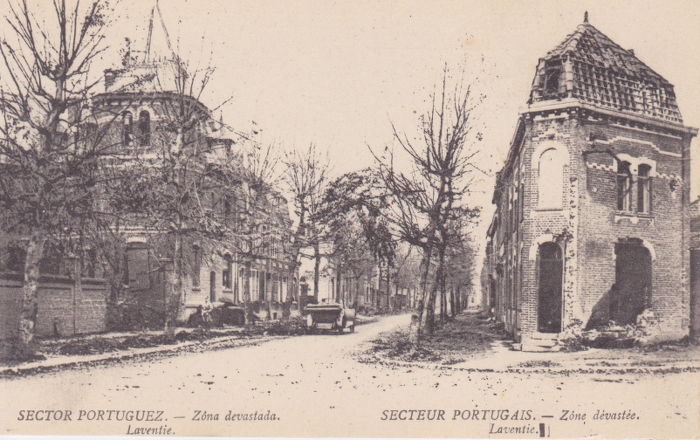
On Easter Sunday, 23rd April, 48563 Pte Phillips records (incorrectly noted as Palm Sunday in his diary) that (even so close to the Front line) “the French people are out in their bloom today – quite a strange site.”
As we have seen before, the O.C. always wanted to improve any location the Unit took over and La Gorgue was no exception. On Wednesday 26th work was commenced on building new latrines for the men and the casualty receiving room and dispensary were painted and whitewashed. As the horse lines were found to be in a very unsatisfactory condition when taken over by the Unit, a fatigue party was tasked with cleaning them up and removing the manure which had accumulated around the lines.
Map 7
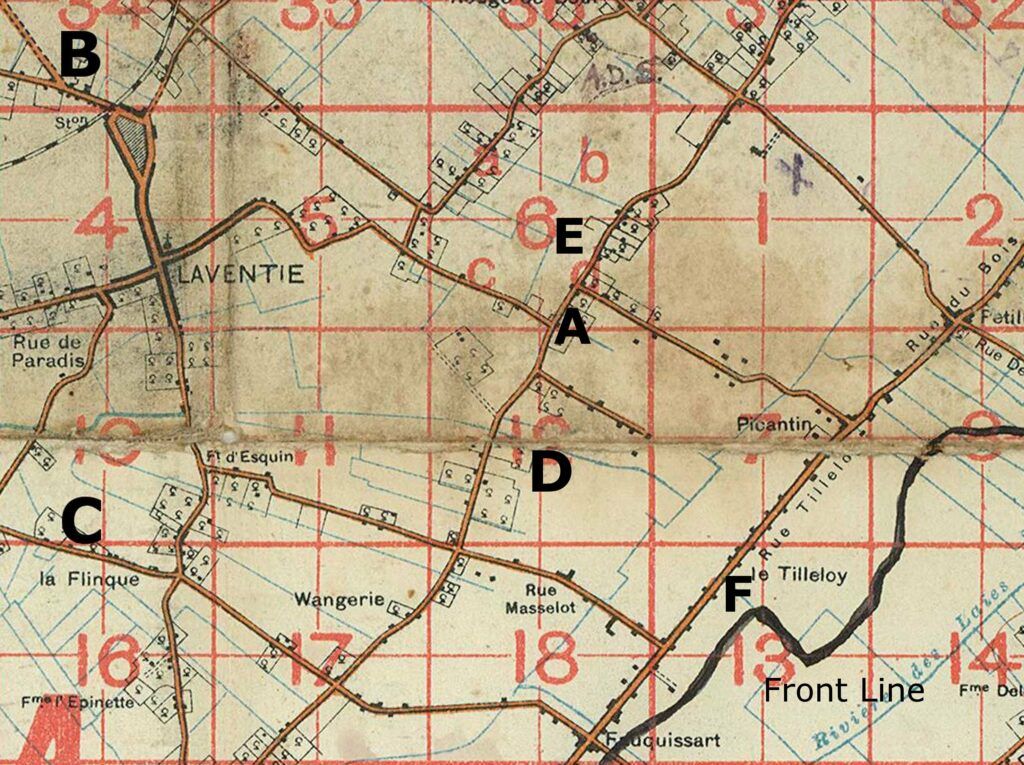
A = Red House Aid Post, B= A.D.S. Laventie, C< = A.D.S La Flinque, D = Hougamont Aid Post, E = Red House (13th London) Cemetery, F = Rotton Row (a communication trench leading back from the front line towards the Aid Post).
On the 27th, 48554 Pte G H Jickells recorded that he and his pal T J Jones (probably 48555 Pte Thomas J Jones), had a busy time as at 2am when on duty at Red House Aid Post, they were called to fetch a case (wounded) from Bicanton Trench. They brought the patient to the M.O. based at Red House and got his wounds properly dressed and took him to the the A.D.S. about 3 miles away. Ten minutes after they arrived back from the A.D.S., they were called out again to go and help the regimental stretcher bearers to bring out a dead man from the front line down Rotton Row. This man was likely to have been 20976 Pte Fred Coles from Abertillery, of the 10th Battalion, South Wales Borderers (S.W.B.), also know as the 1st Gwent. The 10th S.W.B. had been manning the front line trenches since the evening of the 23rd and were due to be relieved by the 11th S.W.B. (2nd Gwent) at 7pm on the 27th. 20976 Pte Fred Coles is buried in Red House (13th London) Cemetery which is situated a few hundred yards north of Red House on the opposite side of the road.
Both 48554 Pte G H Jickells and T J Jones were relieved at 2pm that afternoon (and returned to the A.D.S. at Laventie) and being so tired went to bed at 8pm only to be woken at 11pm and ordered to dress and parade, as they were expecting a gas attack. This was a new experience for the men of the 130th (St John) Field Ambulance and they were stood to for 2 hours, in the meantime all the horses were galloped 5 miles behind the lines. This same gas attack was also recorded by Capt Ffoulkes who wrote in a letter home that there was a Gas alarm on the night of the 27th April and had all the men at the A.D.S. at Laventie “paraded in gas helmets and all the wagons harnessed up and sent back about a mile and a half. Luckily there was practically no gas at all – just a faint smell of chlorine in the air, but all night there was great activity in the line. The Cardiff City (battalion) had gone in (to the line) that night and about 5.30am, casualties started streaming in. They were mostly rifle grenade wounds”.
On Friday 28th, work was continued on the men’s latrines and horse lines and the Hospital was inspected by the A.D.M.S.
22nd Week at War – 29th April – 5th May La Gorgue
(Map sheet 36A L34.b6.2)
On Sunday 30th, the A.D.M.S. instructed the Unit to arrange for an Officer and 30 men to parade near the Divisional Recreation Room at La Gorgue at 11.30am when General Sir Charles Monro presented medal ribbons to the Officers and men of the 38th (Welsh) Division who had been awarded decorations.
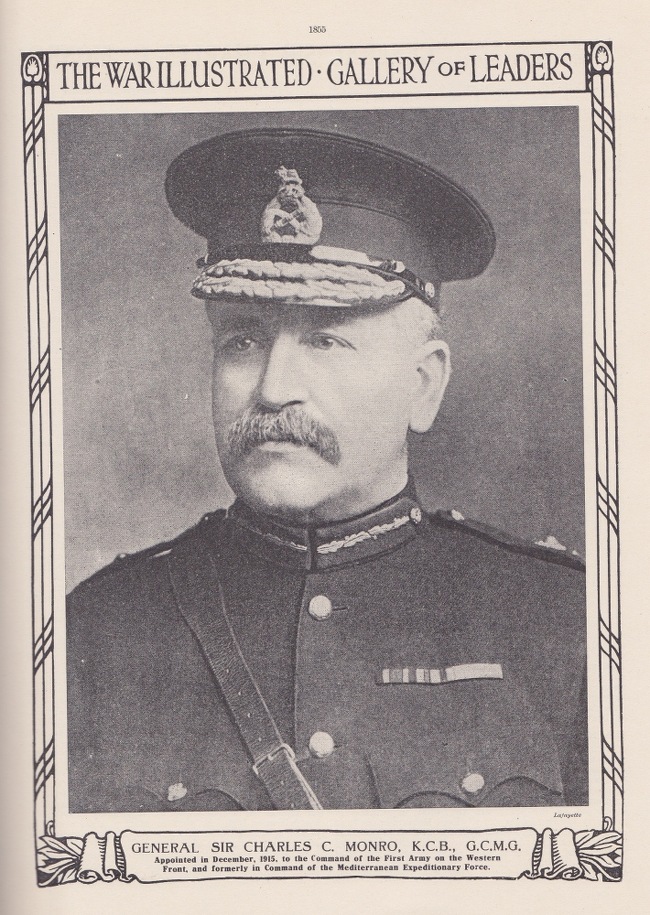
Also on the 29th, 48554 Pte G H Jickells recorded in his diary that while on duty at Hougamont Post, he and 48144 Pte Llewellyn Jones got permission to have a walk down to the front line (by the communication trench that stretched from the Aid Post to the front line trenches) which were manned by the 16th Battalion Welsh Regiment (Cardiff City) as he wanted to see a couple of friends of his. The relief came down (to the Aid Post) at 2pm but the two men did not get back to the A.D.S. at Laventie until 6pm! Both men had to report to Capt Ffoulkes and give an explanation for their late return. 48554 Pte G H Jickells recorded that they both got a bit of a lecture from Capt Ffoulkes on their duties etc but avoided any further action as Capt Ffoulkes conceded that they had obtained permission from the M.O. of the Cardiff City Battalion.
For the next six weeks or so, the Unit’s War Diary largely consists of lists of the number of sick and wounded Officer and men admitted and transferred i.e.. 5th May: Cases admitted 8am on 4/5/16 to 8am on 5/5/16 – Wounded 3 Officers, 4 Other Ranks: Sick 15 Other Ranks. I have not included these figures in the text of this history except where they help to illustrate the activity of the Unit during a particular day. During this time, while stationed at the Hospital, 48563 Pte Phillips records doing a week on night duty alternating with a week on day duty, the switch overs occurring on a Saturday. He recorded that the weather was “very warm again” on Saturday 29th April and that on the 30th he was “feeling in the pink of condition” and on the 1st May he went for a walk to Estaires and Sailly.
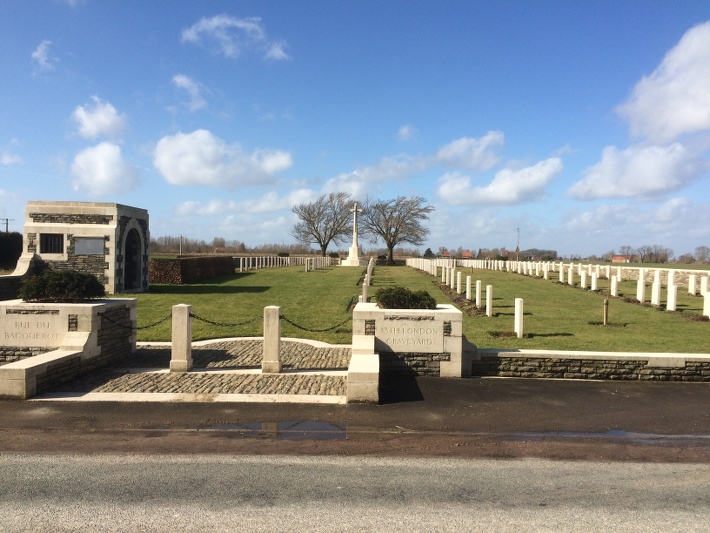
On the 1st May, 48554 Pte G H Jickells recorded that he was one of a party (of men) to march back from the A.D.S. at Laventie to the Unit H.Q. at La Gorgue and further records that while back at H.Q., they had a good time. During his time back at La Gorgue, the weather was lovely and that they always had 2 men on duty at a certain place on the canal bank from 9am to 5pm for bathing parades.
On the 2nd of May, the Unit was visited by the D.A.D.M.S. in reference to the estimated 100 tons of old manure that had been left on the horse lines by the 19th Division and arrangements were made with a local farmer just outside La Gorgue, for this manure to be placed on his land. What an unpleasant fatigue for the men of the Unit!
The men of the Unit were inspected in full marching order by the A.D.M.S and the men’s gas helmets, goggles, contents of valises and haversacks including their clothing and boots were examined and found to be most satisfactory.
Wednesday 3rd May saw the arrival of 71215 Pte David David of Bridgend, possibly the first reinforcement posted to the Unit. He would eventually be one of the 12 men of the Unit exchanged with the St John Hospital in Etaples in January 1918 but more of that later.
Friday 5th May was the Unit’s 13th pay day in France and 48563 Pte Phillips received 10 Francs.
23rd Week at War – 6th May – 12th May La Gorgue
The Hospital was inspected by the D.D.M.S. XI Corps in company with the A.D.M.S. 38th (Welsh) Division on the 6th May and 48563 Pte Phillips changed from day to night duty at La Gorgue and had a quiet night.
Time went by quickly records 48554 Pte G H Jickells in his diary,especially with us general duty stretcher bearers. Every three days we should be on guard, either at H.Q., the (Divisional) Laundry or the Corps Rest Station. All the above guards were for 24 hours, falling in at 9am properly dressed and clean and we were dismissed the following morning for the rest of the day. We were always detailed for guard, 3 men and an NCO and our beats were 2 hours on and 4 off. Not such a tough time!
On Monday 8th May, the Lt Col Davies carried out a clothing inspection of the men at the A.D.S. at Laventie and did the same for the men at the Unit HQ at La Gorgue on the following day.
24th Week at War – 13th May – 19th May La Gorgue
On Saturday 13th May, Lieut Thomas J Buckley returned from leave and reported for duty with the Unit and 48563 Pte Phillips changed from night to day duty and had a busy day.
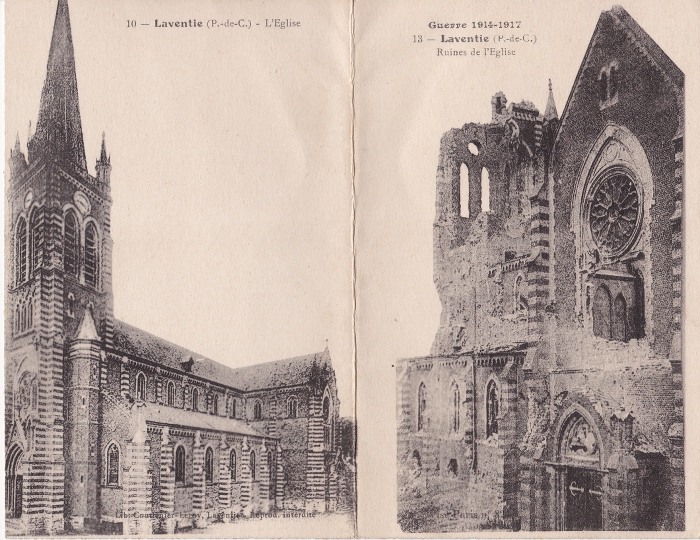
Laventie Church in 1914 and again in 1917 showing the destruction done by several years of war.”
On the 15th May, Capt Anderson relieved Capt Ffoulkes at the A.D.S. at Laventie and Capt Ffoulkes proceeded to the 13th Battalion the Welsh Regiment (2nd Rhondda) to relieve their MO Lieut Reynolds who reported to duty for training with the 130th (St John) Field Ambulance at La Gorgue. Capt Ffoulkes described his time with the 13th Welsh in a letter home dated 26th May 1916. “A great number of medical officers are now undergoing a course of instruction at Field Ambulances and we are put in regiments to replace them. I came to this battalion on my birthday – the day before they proceeded to the trenches. They were then completing 8 days rest at the town where the headquarters of our Field Ambulance is (La Gorgue). We came to the trenches for four days, then went into reserve for four days to the small town where the Advanced Dressing station is situated (Laventie). We came to the trenches again last night, remain here for 4 days, then in reserve for 4 days after which the battalion will go into rest for 8 days and then proceed to another part of the line but I shall probably not be with them then. The work is quite interesting but has the disadvantage that we are never settled long in the same place”.
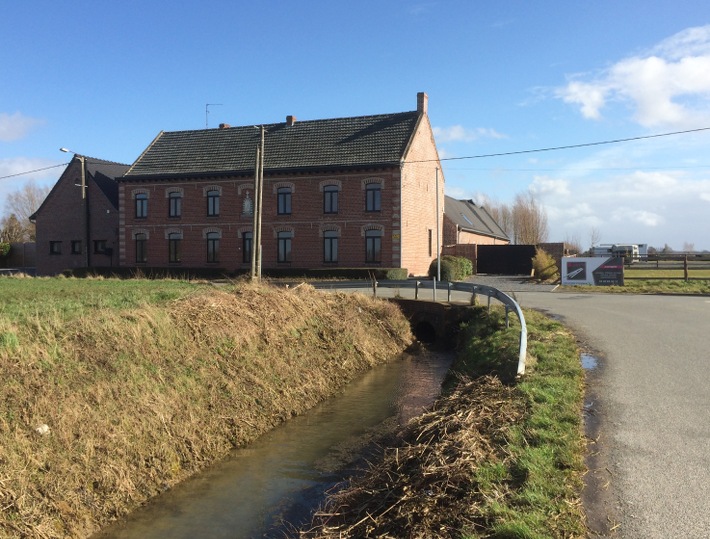
This photograph of the rebuilt Red House is taken looking east towards the front line, standing on the road back to Laventie. The Red House (13th London) Cemetery is a couple of hundred yards to the left.
Capt Ffoulkes letter continued. “We had a moderately quiet time in the line and casualties have been few and only 3 or 4 fatal. I had a good deal of work to do the first few days – improving the sanitary conditions of our surroundings etc and things are now fairly well established. I am attached to battalion headquarters (when in the line – this was located at Red House where the Unit also had an Aid Post) which consist of the Colonel – Colonel Packe, Major Edwards, second in command, the adjutant, machine gun officer and I. We have quite a decent roomy dug out as a mess. I have a dug out close by as sleeping apartment and an adjoining one which serves as a dressing room. In this area the line is in splendid condition and at times it is difficult to realise that the Hun is only 300 yards away. His own parapet is also in good condition (we have occasional peeks at it through a periscope) but it looks a trifle lower than ours.”

German aeroplanes bombed La Gorgue and outskirts on the 16th but no men of the 130th (St John) Field Ambulance were injured. On the same day, Lt Anderson proceeded on leave as did Lt Burke who had been on duty at the Labour Corps Hospital. Lt Burke was able to go on leave in place of Capt Anderson (MO of the 19th Pioneer Battalion, the Welsh Regiment) whose leave was cancelled due to an outbreak of small pox in their camp!
On the 17th a medical inspection of the men of the Unit was carried out and the summer horse standing was completed and put to use.
The Units 14th Pay day in France occurred on Friday the 19th and 48563 Pte Phillips received 20 Francs!
25th Week at War – 20th May – 26th May La Gorgue
On the 21st, 48563 Pte Phillips managed a trip to Hazebrouck and on the 23rd witnessed an aeroplane duel which he described in his diary as “Excitement intense.”
The night of the 24th saw a large number of wounded being admitted to the Unit.
On Friday 26th, Lt Col D E Evans, the OC of the 2/3 Welsh Field Ambulance reported to the Unit and was shown by Lt Col Davies the Main Dressing Station (M.D.S.) at La Gorgue and also the Divisional Baths, Laundry and Labour Corps Hospital at La Gorgue, the Unit’s A.D.S. at Laventie and the Units old M.D.S. at Mesplaux. He was also shown the new steel shelter, now completed with window and door, all thoroughly sandbagged at Laventie East Aid Post: all the work of the men of the Unit and also the Aid Posts at Red House and Hougemont, where the men of the Unit were constructing a further shelter.
26th Week at War – 27th May – 2nd June La Gorgue
48071 Sgt Maj William Stroud proceeded on leave in the evening of the 27th and Lt Col Davies visited the A.D.S. at Laventie and reported that the work of filling in the new shelter at Hougemont Post had started. Lieut Buckley was posted for temporary duty to the 119th Brigade R.F.A. on the 28th and the following day, Lieuts Anderson and Burke returned to the Unit from leave.
On the 31st, the M.D.S. at La Gorgue was visited by the G.O.C. 38th (Welsh) Division who expressed his satisfaction with the arrangements and work carried out by the Unit which he wished to be notified to the Officers and other ranks of the Unit.
26th Week at War is continued in June.
27th Week at War – 3rd June – 9th June La Gorgue
Men of the Unit had been employed in constructing a new steel shelter at the back of the MO’s dugout at Hougamont. The engineers had supplied all the materials but the erection of the shelter was done entirely by the men of the Unit.
On Tuesday 6th June, the Unit headquarters at La Gorgue were visited by Lt Gen Sir R C B Hakling KCB, commander of XI Army Corps accompanied by the DDMS XI Army Corps and following this visit a message was received by the OC from the ADMS 38th (Welsh) Division stating “The Corps Commander has expressed himself very pleased with all he saw at your Field Ambulance on his inspection.”
Capt Ffoulkes reported back for duty with the Unit on Thursday 8th June following his stint as acting MO for the 13th Welsh and Lieut Reynolds returned to duty as the 13th Welsh MO having completed his couse of instruction with the Unit.

Be the first to comment